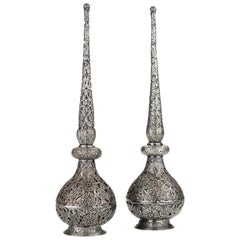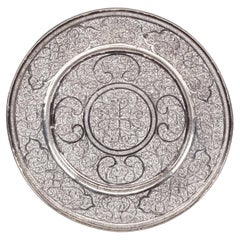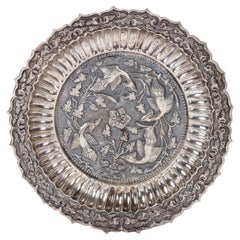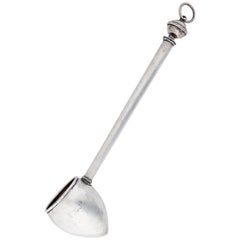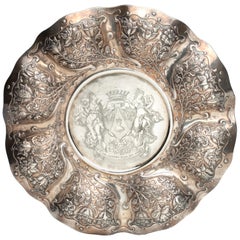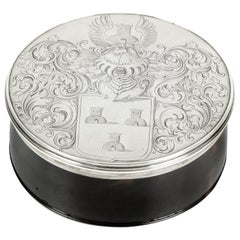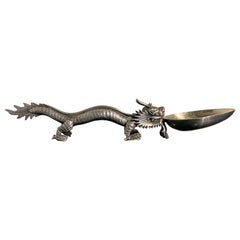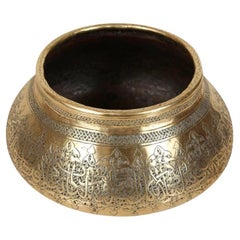Zebregs&Röell Sterling Silver
to
8
6
1
1
1
1
8
8
3
1
1
8
4
3
3
3
2
8
8
8
Pair of Fine Islamic Silver Filigree Rosewater Sprinklers, Early 18th Century
Located in Amsterdam, NL
A pair of very fine silver filigree rosewater sprinklers
Possibly India, Karimnagar, early 18th century
Height 31.6 cm and 31.7 cm, weight 39...
Category
Antique Early 18th Century Indian Islamic Metalwork
Materials
Silver
Splendid and Heavy Late 17th Century Dutch-Colonial Silver Filigree Salver
Located in Amsterdam, NL
A splendid and heavy Dutch-colonial silver filigree salver
Indonesia, Batavia (Jakarta) or possibly Padang, West Sumatra, 2nd half 17th century
Diam. 22.9 cm
Weight 551 grams
This filigree-work was probably done by Chinese masters...
Category
Antique 17th Century Indonesian Dutch Colonial Metalwork
Materials
Silver
Fabulous Indonesian Yogya-Silver Plate
Located in Amsterdam, NL
An Indonesian Yogya-silver plate
Yogyakarta or Kotagede, 1935-1940, marked, (alloy) 800 and maker’s mark PH (Prawirohardjo, act. from 1935)
Diam. 27.2 cm Weight 454 grams
Th...
Category
Early 20th Century Indonesian Art Deco Sterling Silver
Materials
Silver
Rare Dutch Caribbean Silver Water-Scoop Curaçao, circa 1873
Located in Amsterdam, NL
A rare Dutch Caribbean silver water-scoop
Curaçao, circa 1873, indistinctly marked, engraved with initials G R P
Measures: L 35 cm, weight 221 gr...
Category
Antique 19th Century Caribbean Dutch Colonial Sterling Silver
Materials
Silver
Dutch Colonial Silver Dish with the Von Pfeffel Coat-of-arms, 17th Century
Located in Amsterdam, NL
An unusual Indonesian lobbed silver dish
Jakarta (Batavia) or Coromandel coast, third quarter 17th century, apparently unmarked
The eight lobbed dish exuberantly decorated with floral motifs, with the middle section replaced, consisting of indistinctly marked German silver from the early 19th century, bearing the coat-of-arms of the Von Pfeffel family.
Diam. 30.5 cm
Weight 461 grams
Note:
Lobbed silver dishes with exuberant floral decorations were characteristic of the decorative arts in the Netherlands in the first half of the 17th century. This style of floral decoration was adopted by silversmiths as well as by furniture makers working on the Coromandel Coast and in Batavia, often by workers who had fled the Coromandel Coast because of war and famine. In Batavia this style was known as “Custwerck” (work from the Bengal coast).
These lobbed dishes are seldom marked. Only after 1667 the use of the town mark became obligatory in Batavia but only for silver made in Batavia not for silver imported in Batavia from other VOC settlements. The engraved coat of arms in the centre is a replacement of the original centre.
The coat of arms can be identified as those of Christian Hubert von Pfeffel (1765- 1834). As a diplomat, statesman, ambassador of Bavaria in London and Saxony and councillor to the King of Bavaria, he was made “Freiherr” in 1828 and since then used this coat of arms. His son Karl Maximilian Friederich Hubert Freiherr von Pfeffel (1811-1890) in 1836 married Karoline Adelheid Pauline von Rottenburg (1805-1872), the natural daughter of Prins Paul von Württemberg (1785-1852) and his mistress Margrethe Porth. Paul was the jounger brother of the King Wilhelm I of Württemberg (1781-1864). The heraldic motto of the von Pfeffels Vur Schande habe den Huot means as much as “Beware of Shame”. Christian Hubert Theodoor Marie Karl von Pfeffel Karl Maximilian’s grandson was the last male in the von Pfeffel line. His daughter, Marie Louise (Paris in 1882 - Cornwall 1944), born and grown-up in France, changed her name in de Pfeffel. She was the great grandmother of Boris Alexander de Pfeffel Johnson, the present British Secretary of State. None of the members of the von Pfeffel family had any direct links with the Dutch East Indies but indirectly by way of the Royal House of Württemberg they did.
Sophia Frederika Mathilda von Württemberg (1818-1877), daughter of Wilhelm I King of Württemberg, in 1839 married Willem III...
Category
Antique Late 17th Century Indonesian Dutch Colonial Sterling Silver
Materials
Silver
Fine 17th Century Dutch Colonial Armorial Tortoiseshell & Silver Box, Dated 1691
Located in Amsterdam, NL
A dutch tortoiseshell box with two engraved silver plaques
Amsterdam, 1691, with maker's mark of Steven des Rousseaux (1654-1733)
H. 5 cm
Diam. 12.5 cm
Note:
Steven des ...
Category
Antique 17th Century Dutch Sterling Silver
Materials
Sterling Silver
Colonial Silver VOC 'East-India Company' Ingot
Located in Amsterdam, NL
A silver 'V.O.C. AMSTERDAM' ingot
circa 1738, with monogram and the assay mark of the Amsterdam Grill family
With V.O.C. monogram and the A for Amsterdam.
L. approx. 15.5 cm
Weight approx. 2000 grams
Note:
The ingots were salvaged in 2004 from the wreck of the VOC indiaman Rooswijk, equipped by the Amsterdam VOC Chamber. The Rooswijk sank on its second voyage to the Dutch East Indies off the English coast on the Goodwin Sands...
Category
Antique 18th Century Dutch Historical Memorabilia
Materials
Sterling Silver
$15,566 / item
Rare 17th Century Silver Reliquary Arm Monstrance
Located in Amsterdam, NL
A rare silver reliquary arm with relic bone, with the coat-of-arms of Cosme Roger (1671-1710), bishop of Lombez, France, with original bone relic
Poss...
Category
Antique Late 17th Century Italian Renaissance Religious Items
Materials
Sterling Silver
Related Items
Chinese Export Silver Dragon Spoon by Wang Hing & Co., Late 19th Century
By Wang Hing & Co.
Located in Austin, TX
A very fine and charming Chinese export silver spoon in the form of a dragon, by Wang Hing & Co., Qing Dynasty, late 19th century, China.
...
Category
Antique 1890s Chinese Chinese Export Metalwork
Materials
Silver
$1,200
H 0.88 in W 5 in D 1 in
Antique Islamic Brass Bowl Fine Metalwork Hand Etched Bowl
Located in North Hollywood, CA
Antique Middle Eastern Islamic art Moorish brass bowl engraved with Thuluth Arabic calligraphy.The polished brass bowl is profusely chased with vines and vegetal motifs and inscribed with Islamic verses of the Holly Koran.This bowl has been professionally cleaned and polished.Measures: Diameter 7.25" x 4" height Mouth opening: 5".Great Middle Eastern brass metalwork decorative Islamic art objects.Handcrafted Moorish hand-etched Islamic metal brass bowl.Engraved, incised and hammered with very fine Arabic Islamic calligraphy writing and geometric designs on brass vessel.Very Intricate fine Middle eastern Moorish Islamic Art metalwork, museum quality artwork.Late 19th Century.Date of Manufacture: Circa 1880.Condition: Wear consistent with age and use.
Islamic brass metalwork is an intricate and beautiful form of art that originated in the Islamic world. It encompasses a wide range of decorative objects made from brass or other metals such as copper, bronze, and silver. Brass trays, in particular, are highly regarded for their craftsmanship and intricate designs.
Islamic brass metalwork has a rich history that dates back to the early Islamic period, with its roots in the metalworking traditions of ancient civilizations such as the Persians, Greeks, and Romans. However, Islamic artisans developed their own unique styles and techniques, blending elements from various cultures and creating distinctive motifs that reflected Islamic aesthetics and religious beliefs.
The process of creating brass trays involves several steps, each requiring specialized skills. Here is a general overview of the traditional techniques involved:
1) Design: A skilled artist or calligrapher creates the design for the brass object. Islamic brass metalwork often incorporates intricate geometric patterns, arabesques, floral motifs, and calligraphy inspired by Quranic verses or poetry.
2) Metalworking: The object is typically made from a sheet of brass or another metal. The metal is cut into the desired shape and then hammered or pressed to create the object. Traditional techniques such as repoussé (hammering from the reverse side) or chasing (hammering on the front side) may be employed to shape the metal.
3) Engraving: The surface of the metal is often decorated with intricate engravings or etchings. Skilled artisans use chisels, gravers, or other specialized tools to create fine details and elaborate patterns.
4) Filigree and Inlay: Some brass trays feature additional decorative elements such as filigree or inlay work. Filigree involves shaping thin wires of brass into delicate patterns and soldering them onto the tray's surface. Inlay work, on the other hand, involves embedding contrasting materials such as silver or copper into the brass, creating intricate designs.
5) Surface Treatment: After the main decorative work is complete, the tray may undergo surface treatments to enhance its appearance. This can include processes like polishing, buffing, or applying various chemical patinas to create an aged or oxidized effect.
While this bowl has certainly witnessed the passage of time, it remains in remarkably good condition, with only minor signs of age that add character to its appearance. The patina on the brass enhances its antique allure, making it a truly authentic and captivating collectible.
Arabic Calligraphy: The Arabic writing on the bowl is a work of art in itself. The calligraphy showcases the mastery of the scribe's hand, with flowing curves and intricate details that form an elegant script. The script may include Quranic verses, blessings, or poetic verses, depending on the bowl's origin and purpose. The inscriptions are not only visually striking but also carry profound meaning, making this bowl a beautiful representation of Islamic heritage.
Intricate Patterns: In addition to the Arabic calligraphy, the bowl features intricate geometric patterns and motifs that further enhance its visual appeal. These patterns are a hallmark of Islamic art and reflect the mathematical precision and artistic creativity that defined Islamic craftsmanship.
This antique Islamic brass bowl...
Category
Antique 19th Century Turkish Islamic Metalwork
Materials
Brass
Dutch Silver Bonbon Basket by Gerrit Van Der Dussen, 1909
Located in Delft, NL
A Dutch silver bonbon basket by Gerrit van der Dussen, 1909.
A Dutch silver bonbon basket with foliate scroll edge and handles and diamond mot...
Category
Early 20th Century Dutch Sterling Silver
Materials
Silver
19th Century Italian Sterling Silver Decorative Box
By Arval Argenti Valenza
Located in VALENZA, IT
Completely handmade sterling silver candy box.
The box is round and pot-bellied.
Embossments and chisels of flowers were made all over the body.
The box is divided into three sect...
Category
2010s Decorative Boxes
Materials
Sterling Silver
Chinese Export Silver Goblet
Located in London, GB
A Chinese silver goblet profusely decorated with chased, richly defined chrysanthemum against a matte background and is supported by two intertwi...
Category
Antique 1890s Chinese Chinese Export Metalwork
Materials
Silver
Chinese Export Silver Jardiniere with Dragons and Figures
By Tuck Chang & Co.
Located in London, GB
A Chinese Export Silver Jardiniere circa 1890, of rectangular form and variously pierced to all four sides. The side with the vacant cartouche has two opposing dragons separated by a...
Category
Antique 1890s Chinese Chinese Export Metalwork
Materials
Silver
20th Century Edwardian Sterling Silver Jewelry Box
By A&J Zimmerman Ltd.
Located in Jesmond, Newcastle Upon Tyne
An exceptional, fine and impressive antique Edwardian English sterling silver jewelry box; an addition to the ornamental silverware collection
This exceptional antique silver jewelry box, in sterling standard, has been modelled in the form of a dressing table.
The surface of this Edwardian jewelry box is plain and embellished with two applied sterling silver balls to the anterior convex arched surface, replicating the details of the draw handles.
The original hallmarked hinged cover is plain and parallels the shape of the body, opening to reveal the original segmented velvet interior.
The weighted base of this exceptional antique box retains the original leatherette covering to the underside.
The box is supported by four subtly tapering pillar style legs
Note: The majority of such boxes have a wood lining to the interior; it is a sign of quality when boxes have unlined interiors in addition to a solid silver cover.
Condition
This antique silver box is an exceptional gauge of silver, exceptional quality and in exceptional presentation condition.
The box has been professionally polished and is in presentation condition.
The original interior and leatherette covering have wear in keeping with age and use.
Full hallmarks struck to the surface of the body and part hallmarks to the interior of the cover are all very clear.
Reflections in photographs may detract from the true representation of this piece of antique Edwardian jewelry...
Category
Antique Early 1900s English Edwardian Jewelry Boxes
Materials
Silver, Sterling Silver
Antique Dutch Colonial VOC Batavian Tortoise Shell Silver Sirih Casket 1750
Located in Portland, OR
A rare, Dutch Colonial, Batavian (now Jakarta) Dutch East Indies silver and tortoise shell Sirih casket, circa 1750.
The casket was used for storing highly prized betel nut, which was chewed ritually by high ranking Indonesian officials and adopted by settlers from the Dutch East Indies Company...
Category
Antique 1750s Indonesian Dutch Colonial Metalwork
Materials
Silver
$5,200 Sale Price
20% Off
H 2 in W 4.5 in D 3 in
Art Deco Sterling Silver Dresser Set
By C.&J. Company
Located in Savannah, GA
Sterling silver Chinese export dresser set includes a beveled hand mirror, one hand brush holder, two round dresser containers with scalloped lids, one c...
Category
Vintage 1930s Chinese Art Deco Metalwork
Materials
Sterling Silver
Antique Islamic 15th Century Mamluk Qalamdan Gold Silver Inlaid Brass Pen Box
Located in Portland, OR
A fine and important late 15th century Mamluk period inlaid penbox (Qalamdan), possibly Syria or Mosul, late 1400's.
The slightly domed penbox is lavishly inlaid with gold and silver...
Category
Antique 15th Century and Earlier Syrian Islamic Metalwork
Materials
Gold, Silver, Brass
$15,000 Sale Price
25% Off
H 2.4 in W 9.75 in D 2.8 in
Italian Mid-Century Modern Silver Box
By Bartolini Bartolozzi
Located in New York, NY
Italian Mid-Century Modern 800 silver box. Rectangular with straight sides and thumb rest. Cover flat and hinged with tab. Allover engine-turned curvili...
Category
Mid-20th Century Italian Mid-Century Modern Sterling Silver
Materials
Silver
Big Antique 17th century key
Located in Chonburi, TH
This Antique 17th-century wrought iron key is a fascinating artifact that transports us back to an era of intricate craftsmanship and timeless elegance. T...
Category
Antique 17th Century Dutch Metalwork
Materials
Wrought Iron
